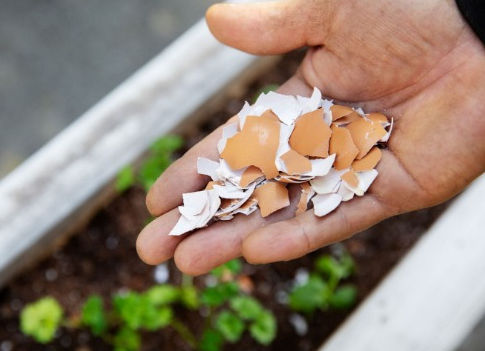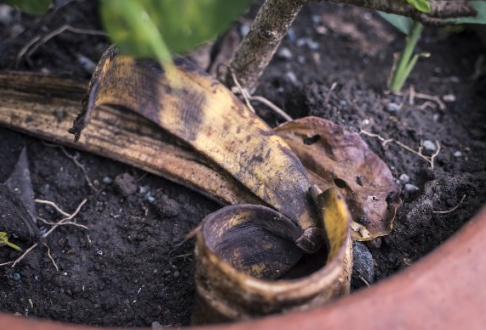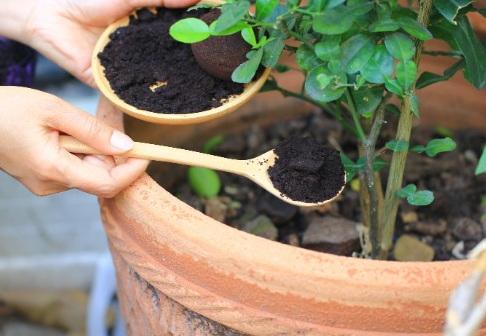Coffee, milk, sugar, eggs, bananas sounds like a typical grocery list. Maybe what you had for breakfast this morning. It’s also a list of ingredients that you’ve been told you should add to your garden to help your plants grow better. Well, that may not be the best advice. I see a lot of the same information over and over again about the things that we can take from our kitchen and put them in our garden and our plants are going to grow better, but so much of that advice is just plain wrong. Let’s begin with eggs as I sit in front of my beautiful tomato plants because you’ve heard that you should bury eggshells and in some cases you’ve probably heard you should bury an entire egg in the soil to benefit the growth of your tomatoes. The idea sounds like it might work tomatoes need calcium, but so do all other plants and humans. Tomatoes in particular show a deficiency in calcium with blossom end rot. If you look at the fruit and the bottom is dark brown and black, it’s probably blossom and drought. It’s a calcium deficiency, so the reasoning goes is that we take our eggshells which are high in calcium, bury them and then the plants will take up that calcium and will eliminate blossom end rot well. There are a number of things wrong with using eggshells to help out your tomatoes. While blossom and rot is due to a reduced uptake of calcium into the plant, it’s most often because of faulty watering. Under watering or over watering is the most common cause of blossom end rot because almost all of our soils have enough calcium, but the soil needs to be moist for the plant to take it up. Too dry, too wet, it doesn’t happen and so adding eggshells is really not going to correct that problem.

Secondly the eggshells just don’t break down in the soil unless you have very acidic soil. You bury an eggshell and it’s going to be there for a long time. It’s the bacteria, the microbes that are in our soil that are going to be breaking down all the things we put into the soil. You can see how this works in a compost pile. You take your organic material, you heap it up and the bacteria breaks it down into compost. If you add eggshells to your compost pile and you’re certainly welcome to do that, at the end when the material is decomposed and ready to go into your garden soil, you’re still going to have eggshells in your compost with all the bacterial growth and all of the heat that a big hot compost pile generates, it’s not enough to break down those eggshells. So why do you think just burying it in the soil is going to work any better.
But of course banana peels are a good idea right because bananas have potassium and all plants need potassium to grow well. Everybody knows that plants need nitrogen, phosphorus, potassium. Bananas sound like a good way to get the potassium in the soil well. There’s some faulty reasoning with that as well. While the banana that we eat may be high in potassium, the peel itself is pretty low and it also needs to be decomposed by the soil microbes. Before it can be used by the plants and during that process of decomposition in the soil, the bacteria use a lot of nitrogen, so by burying a banana peel to get the potassium, we could actually create a nitrogen deficiency which counters everything we’re trying to do to improve our plants. Because of the concern with that initial nitrogen imbalance, if you do put banana peels in your soil, you should not be growing plants directly over that spot until it’s fully decomposed. I love using banana peels in my garden by adding them to my compost pile and letting the bacteria break it down separate from my soil beds. I’ll still get the benefits just like any other organic material that I’m composting, but I don’t have to worry about wasting time, putting it into the soil, waiting for it to decompose and really not getting the potassium benefits that I expect.

I can’t stress enough the importance of the microbe in soil and in a compost pile when it comes to these organic materials that we’re using in the garden. We tend to think that if we’re eating something and it gives us that nutrient, then it would give the garden that nutrient as well, well, sure, it can happen that way. But you got to remember that our guts, our stomach, our intestines are loaded with microbes. It’s the trillions of bacteria in our body that are breaking down our food so that we can absorb the nutrients. It’s the same thing in nature in our garden. All of that material must be broken down by those microbes to be usable by the plants. And so just because our bodies can break down our food for our benefit, it doesn’t mean that the same benefit goes to the plants. It can be a total waste of time. Like with milk, I’ve seen a number of videos on this recently where we just add milk to our tomatoes or our cucumbers or any plant, and it’s that boost of calcium that improves all of our fruit well.

Just like with the eggshells, if we’re trying to cure Blossom end rot with milk, we’re not really identifying the real reason we have Blossom end rot. And so what we’re doing is just wasting milk and in the process probably making our garden smell pretty bad, as the fats in that milk, which have no benefits to the plants. Adding a food like that, any fatty food to your garden can create more problems than it could conceivably solve the same with sugar. I have a good gardening friend, another gardening educator like me and in his classes, he says to give the tomatoes sugar, sugar makes your fruit taste sweeter. Well, there’s absolutely no research that supports that the sugar is going to be consumed by the bacteria very quickly, and there’s really no nutrients within the sugar that the plants are going to take up. Just like there’s not a lot of nutrients and sugar for us. Even though some of us have a sweet tooth and just can’t stop eating sugar, it’s not benefiting our health. Milk sugar for tomatoes are any plants in your garden. You’re just wasting your money, go ahead and consume it yourself.
How about Coffee Grounds? I know you’ve seen a video about using coffee grounds in the garden. We’re always trying to find something for our scraps. We have a cup of coffee in the morning, the grounds are left over. Let’s take them out to the garden and Coffee Grounds can be a good organic addition to your garden. But Coffee Grounds are going to lower soil ph and to deter slugs and snails. Really doesn’t work so well. If you want to lower your soil ph, you add an acidic material, so everyone knows coffee is acidic. It makes sense that we would add coffee grounds to lower the ph, but what’s missed is what you do in your morning routine. You drink the coffee and most of the acid that’s in that coffee goes in through your mouth into your gut. It doesn’t stay behind in those coffee grounds, so when we add the coffee grounds to our soil to lower ph, it has minimal if any effect and as it decomposes, the effect is lost completely. If you’re looking to lower your soil ph, look to a longterm change. Sulfur is the most common thing we should be adding to our soil to lower the ph. Don’t use other kitchen products like vinegar. Vinegar, also very acidic, makes sense to add to our soil to lower the ph. Secondly, it can kill a lot of those beneficial microbes that we need to actually break down the organic material in our soil. And what about the deterrence for slugs and snails and along with eggshells? No doubt you’ve heard that you put the crushed eggshells or the coffee grounds around the plants and they’re not going to crawl across it because someone looked closely and saw lots of little rough, jagged edges and assumed that they’d be too rough and jagged for those tender snails and slugs. Well you can do a simple search and find some videos that show slugs and snails crawling right across coffee grounds and crushed eggshells. They have no effect, no deterrent value when you use them in the garden and as soon as you water or it rains, they wash into the soil and any effect that might have been there is lost forever. A better way to use coffee grounds in your garden is through your compost pile. It’s organic material. It actually counts as a nitrogen component when you add it to your compost. But unlike the leafy greens that will break down pretty quickly, it does take a while for the coffee grounds to decompose. You might also consider using coffee grounds as a mulch when you mix those grounds with some dried grass or straw or sawdust. Because of that tendency to take longer to break down, it can become an effective mulch.

You really should be cautious about listening to tips for using household ingredients in the garden and sometimes they can actually cause the problem that you’re trying to prevent. The best example of this is Epsom salt. Now Epsom salt is magnesium sulfate and plants need magnesium and plants need sulfur. And no doubt you’ve seen a video that’s touted the wondrous benefits of adding Epsom salts to your garden, especially for your tomatoes and to end blossom end rot well. Unless you have a magnesium deficiency in your soil, you really shouldn’t be adding it because the Epsom salt can actually increase the magnesium levels to a point that it blocks out other nutrients. And what’s one of those nutrients that it blocks calcium. Remember, blossom end rot is a calcium deficiency. So by using Epsom salt, you could actually be blocking the intake of calcium to your tomato plants and causing the very problem that you’re trying to prevent.
A better way to use Epsom salt is in a tub of hot water to soothe the sore muscles you get from working in the garden. So do I use any household ingredients? Do I take any of those tips for improving my plants? No. I don’t. I don’t even use fertilizer in my vegetable garden. I’m focused on amending my soil, taking some of those kitchen scraps, turning them into compost, and then adding that compost or aged manure or other organic materials to my soil to feed the soil, increase that microbial activity. And that’s what makes all the nutrients that are in the soil available for my plants. Sure, it’s a little bit of work I might need to soak my sore muscles, but it’s proven to work with a lot of research and a lot of gardeners that do it that way. Enjoy gardening and don’t forget to share this article with your friends.

